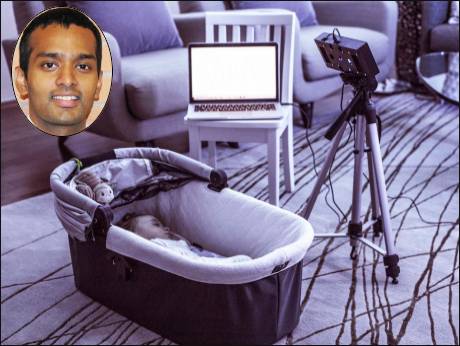
An Indian-American researcher demonstrates the potential of smart speakers to detect cardiac arrest -- and potentially tell, if a patient suffers from a chest infection, like coronavirus|
Bangalore, June 23 2020:
Beyond obeying voice commands, smart speakers -- as researchers are finding -- have an even bigger potential to monitor the health of people around them, in real time.
For some six years now, a team at the Allen School of Computer Science and Engineering at the University of Washington (UW) in the US, has been exploring the exciting possibilities of harnessing the passive listening capability of a smart speaker to analyze sounds like a nearby person's breathing. Associate Professor Shyam Gollakota (an MIT ( US) and IIT Madras alumnus) and his team, used smart speakers to pick up the irregularities in people's breathing patterns, while they slept.
__________________________________________________________________
This story will appear in the July 2020 issue of Science Reporter (Vol 57 issue 7)
--------------------------------------------------------------------------------------------------------------
Specifically, they picked up the guttural, gasping noise that accompanies nearly half of all heart attacks. They used large samples of breathing data to fine-tune an algorithm so that it could differentiate between harmless snoring and what is known as agonal breathing that precedes a cardiac arrest. The work is in proof-of-concept stage, but Prof Gollakota and his co-researcher Prof Jacob Sunshine of the university's School of Medicine, suggest what makes this technology so compelling: it could help detect more heart patients , before they had an episode and in time to be treated.
In a related project, Prof Gollakota and his team developed a smart speaker to monitor the breathing and the movement of babies , even as the devices transmitted white noise to soothe them to sleep. Called BreathJunior, the system records the white noise as it is reflected back, and detects the breathing motion of the infant's tiny chest, otherwise difficult to catch without a contact instrument. ( white noise is a combination of different sound frequencies).|
Covid-19 opportunity
Out of crisis springs opportunity: the recent coronavirus pandemic presented Prof Gollakota and his associates with their greatest challenge. The same technology which identified the gasp of an imminent heart attack, could, in theory, be used to detect a persistent cough that often characterises a Covid-19 patient. The team is also experimenting with making the speaker emit high frequency tones beyond the human range of hearing ( like a dog whistle). The reflections bouncing off a patient, could track chest motion and extract information about his or her breathing rate. As you read this, teams from UW are testing in many homes in Seattle, the hypothesis, that a person's breath and cough might predict the onset of a respiratory infection. Imagine the huge advantage of being able to monitor dozens of patients in a hospital ward, with no human intervention, no equipment connected to them -- and no danger of medical attenders picking up the infection!
Dr Gollakota and Dr Sunshine "broke" the news of the exciting possibilities offered by deploying smart speakers in just such a scenario in an op-ed article in the New York Times in early April this year. The editors titled the story: 'Alexa, Do I have Coronavirus?', a journalistic overstatement perhaps -- but one that could well be true, a few months hence, when research translates into a usable tool.
The authors conclude: "Smart devices, which have connected us to family and friends during these difficult times, have an unrealized potential, and we should demand that platform providers and the government work to responsibly enable it."